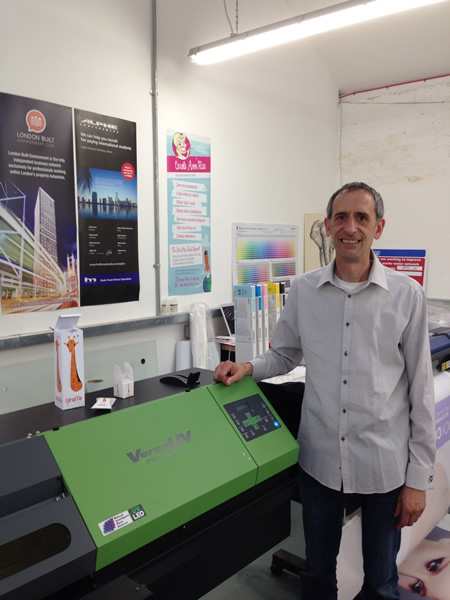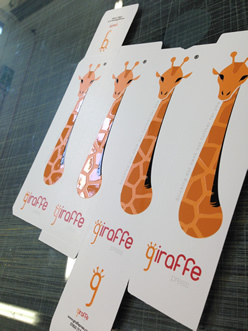This Roland roll-fed UV printer promises the freedom to print to a wide range of media, but does it live up to this? Nessan Cleary asked user Jason Pavlou, managing director of Giraffe Press.
It’s easy to think of UV machines as being for rigid materials and solvents for flexibles but there is a class of UV roll-fed printers that can cope with a wide range of different substrates. These printers are more expensive than their solvent counterparts but their prints cure to a tough finish without the need for lamination and the freedom to use less standard media can lead to a wider range of applications. This is the thinking that led Roland to develop its VersaUV LEC printers. And it's also the reason that Jason Pavlou, managing director of Giraffe Press, bought one back in the summer of 2013.
Pavlou says that it's “bloody brilliant”, adding: “It's very capable and adaptable. It can print to pretty much anything up to 1mm thick.”
He says there are a few media that the ink will print to but slips off easily, but says these are a rare exception. Otherwise Pavlou says that the UV ink dries instantly and that there's no risk of damaging delicate media because there's no heat from the LED curing. He adds: “The UV ink is food safe which is very useful for a lot of food packaging.”
Giraffe Press is a print studio based in Lambeth, south London, that mainly handles vehicle graphics. Pavlou had been looking for a second, larger machine to help expand his business and was immediately interested in the LEC, which had only recently come out at the time. He was already using a Roland VersaCamm 42ins VS420 but realised that the UV printer would allow him to cater for a very different range of applications.
Pavlou mainly uses the VersaUV for prototyping packaging, noting: “That's really what it's designed for more than anything else.” But he says its really down to the ideas you come up with and other jobs have included clear plastic business cards.
The VersaUV includes a built-in cutter complete with a scoring tool, which Pavlou says is helpful for packaging work: “You can score the prints first and then cut them out.”
Giraffe has opted to have white and clear inks installed alongside CMYK. Pavlou explains: “You can get up to seven coats of clear gloss varnish for a nice embossing effect.” He also notes that the white ink on the UV printer is a lot more opaque than with the older VersaCamm.
Pavlou concludes that he has no regrets over the VersaUV: “It has brought in work that I wouldn't have had if I had not had that machine.”
About the product
The VersaUV LEC-540 is a combined UV-curable printer and cutter. It uses LED curing and can print at up to 1440dpi resolution. It’s a six channel printer with CMYK plus a choice of two whites, two gloss or one of each.
It can print at up to 11.7m2/hr. There’s a choice of two sizes, with the 540 taking 1371mm wide, and a smaller 340 size for media up to 762mm wide, though the 540 has larger lamps making it faster.
When it comes to cutting it can handle materials up to 0.4mm thick, with a blade force of up to 300gf. It can cut at up to 600mm/sec.
It comes with Roland’s own VersaWorks Rip
Alternatives
There are a couple of other roll fed UV printers that are worth considering though none of these include the cutting element that the Roland has.
Fujifilm
We looked at the Fujifilm Acuity 1600 in last month’s On Test. This also offers CMYK plus white and varnish with LED curing. It’s 1.6m wide and runs at up to 20m2/hr.
Mimaki
Mimaki has the UJV-160, designed as a hybrid 1.6m wide UV printer, also using LED curing. There’s a choice of four or six colours plus white, but there’s no clear ink option.
Mutoh sells the ValueJet 1617H, which is also designed as a hybrid machine. It has a white ink option but no clear ink.



